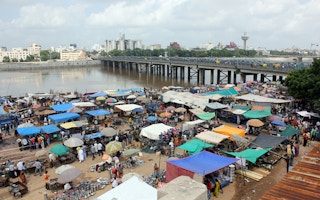The 2013 World Population Data Sheet describes the growth of large cities in Asia as a remarkable demographic story. Many of the world cities which are growing the fastest are in the region, and Asia already accounts for most of the urban population of the world.
To continue reading, subscribe to Eco‑Business.
There's something for everyone. We offer a range of subscription plans.
- Access our stories and receive our Insights Weekly newsletter with the free EB Member plan.
- Unlock unlimited access to our content and archive with EB Circle.
- Publish your content with EB Premium.
The changing nature of Asia’s urban landscape poses serious challenges for sustainable development. Rapid urbanization means that city leaders need to put sustainable development at the heart of infrastructure planning and in places, make fundamental changes to the infrastructure that keeps cities running. I’m talking about things like the water supplies, electrical grids, transport systems and telecommunications. This is no easy task and city leaders cannot do this alone.
“
This week WBCSD launched a report summarising the findings of the [Urban Infrastructure Initiative] in cities that want to make a transformative leap to sustainable development
The World Business Council for Sustainable Development is running a major global programme – the Urban Infrastructure Initiative – to facilitate dialogue between city leaders and businesses to help achieve this. We’ve been working in countries across Europe, the United States, Latin America and also in six cities in Asia: the four largest cities in Gujarat State in India, Kobe in Japan and Yixing in China.
This week WBCSD launched a report summarising the findings of the initiative in cities that want to make a transformative leap to sustainable development. It includes recommendations for each city. Some are already taking these recommendations on board.
Let’s focus in on Yixing. Located in the Chinese province of Jiangsu, Yixing has a rich history. Established in 4th century BC, the city is widely known as the ‘Capital of Chinese Pottery’ and is famous for its eco-tourism in wide spaces of natural beauty, local lakes and waterways.
Officials of the WBCSD and representatives of major companies Schneider Electric, AECOM and Siemens formed the Yixing UII Project Team, who met with the Mayor, Vice Mayor and senior city officials of Yixing to discuss the city’s sustainability aims.
Today, Yixing has a new goal: to become China’s ‘demonstration city of scientific and sustainable development’. Mr Lijun, Mayor of Yixing, our partner in the initiative has high aims, desiring a “green economy and urban and rural co-ordination which is friendly to environment and benefiting the public’”.
The UII team, alongside Yixing officials, formulated strategic plans and actions in order to create an ‘Oriental Water City’ which would be a model for other Chinese urban areas. During the discussions, the broader issue of urban planning was identified, with specific focus points requiring plans of action. From future planning measures to protect Yixing’s wealth of ecosystems, preventing urban sprawl, implementing environmentally-friendly public transport modes and tackling Yixing’s increasing traffic issues are all specific focus points which the initiative addresses.
The work between the UII and Yixing has produced a range of suggested actions, from short term ‘quick wins’, achievable within six months, to initiatives planned for 2020 and the long term sustainability aims of Yixing. A key outcome of the UII engagement is Yixing’s decision to begin a detailed feasibility evaluation to develop a tram system for the city, working with the Chinese NDRC Transport Institute.
But this project goes further. It proves that, although some specific focus points tackle Yixing’s issues, that the broader model of constructive engagement with the private sector can be adopted by other Chinese and Asian cities. We have also engaged with cities in Japan and India, taking a similar approach as Yixing to tailor the sustainability requirements of Kobe and Gujarat to identify effective solutions to realize long-term environmental and sustainability goals.
This is only the beginning and we need city leaders across Asia and around the world to get on board. The challenge and the opportunity are clear: sustainable cities are the key to achieving a sustainable world.
Peter Bakker is CEO of the World Business Council for Sustainable Development (WBCSD). You can find out more about the Urban Infrastructure Initiative and read the report here.











